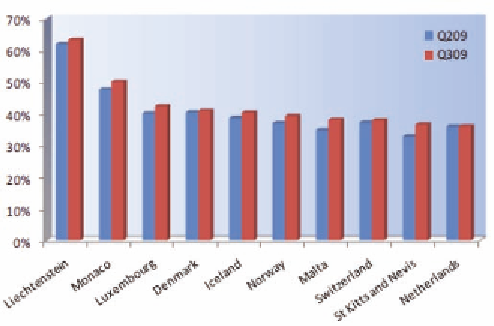Information Technology Reference
In-Depth Information
number of new subscribers over the past year. The
Middle East and Africa comprise a mere 5% of
the world's broadband connections, despite boast-
ing over a billion residents in the region, punch-
ing far under their weight in relative terms. North
Amerca, Western Europe and South East Asian
feature just short of seventy percent of all broad-
band connections on the planet (Point-Topic,
2009).
As per their calculations, the leading countries
in penetration of broadband lines are depicted in
Figure 3 below. This largely mirrors the results
of the OECD study, with the notable exception of
the principalities of Liechtenstein and Monaco.
It is surmised that their extremely high level of
affluence, coupled with the miniature amount of
geographical space occupied, resulted in them
topping the chart.
Although South Africa doesn't feature in either
of these reports, comparisons between it and the
leading broadband nations are immediately ap-
parent. South Africa's broadband penetration, at
less than four percent (Goldstuck, 2009), is out-
classed by emerging markets such as Mexico and
Turkey and dwarfed by developed countries such
as those depicted above, most of which feature
ten times the level of penetration achieved
within South Africa.
A study by Cisco and the University of Oviedo
(BBCNews, 2009) recently clustered countries,
based on the quality of their broadband services,
into four categories, namely 'ready for tomorrow',
'comfortable for today', 'meeting needs for today'
and 'below needs for today' (Table 5).
The leaders are considered to be Korea, Japan,
Sweden, Lithuania, Bulgaria, Latvia, Netherlands,
Romania and Denmark. Somewhat surprisingly,
the United States (categorised as 'comfortable for
today') and the United Kingdom (categorised as
'meeting needs for today') don't appear signifi-
cantly future proof. South Africa, alongside
China, is categorised as being 'below needs for
today'.
DRIVERS AND INHIBITORS
OF LOCAL BROADBAND
DIFFUSION AND ADOPTION
Whilst the penetration of broadband in South
Africa may be serious cause for concern, there
are a number of factors stimulating development.
Goldstuck (2007) identifies three key ongoing
drivers of broadband adoption in the country.
Lifestyle-Oriented Demand:
The new gen-
eration of online gamers, file-swapping enthusiast
Figure 3. Broadband lines per 100 population (Source Point-Topic (2009))

Search WWH ::

Custom Search